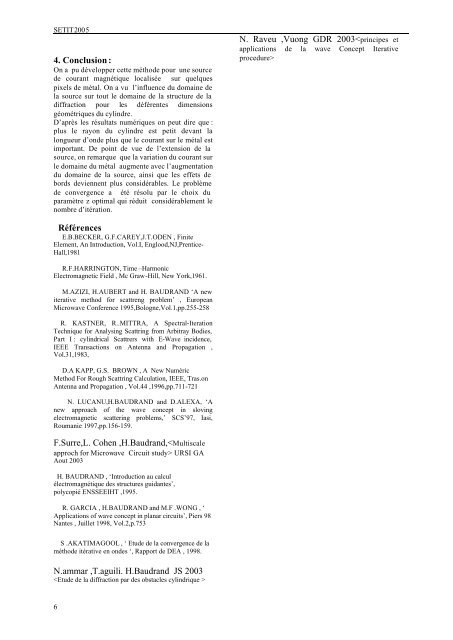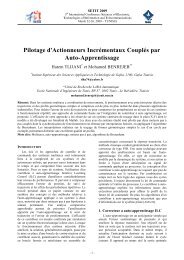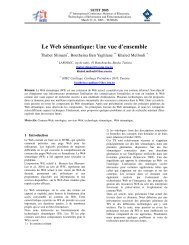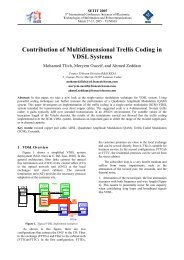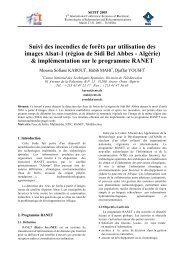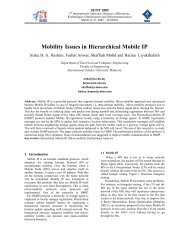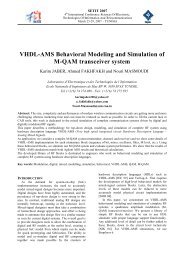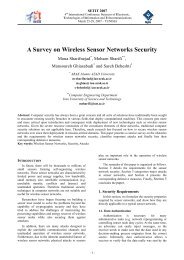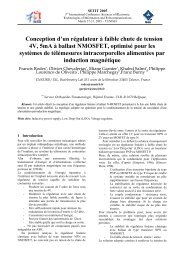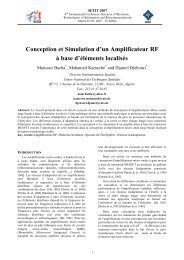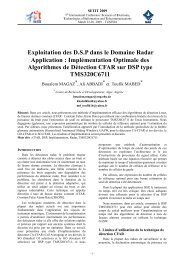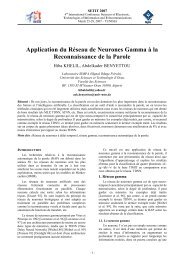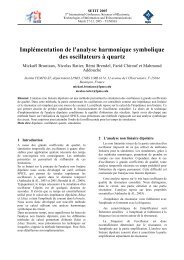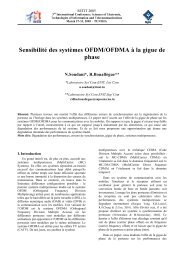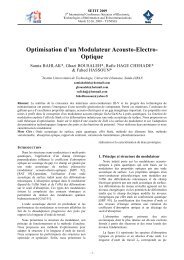Etude de la diffraction E.M par la méthode itérative basée sur le ...
Etude de la diffraction E.M par la méthode itérative basée sur le ...
Etude de la diffraction E.M par la méthode itérative basée sur le ...
Create successful ePaper yourself
Turn your PDF publications into a flip-book with our unique Google optimized e-Paper software.
SETIT2005<br />
4. Conclusion :<br />
On a pu développer cette métho<strong>de</strong> pour une source<br />
<strong>de</strong> courant magnétique localisée <strong>sur</strong> quelques<br />
pixels <strong>de</strong> métal. On a vu l’influence du domaine <strong>de</strong><br />
<strong>la</strong> source <strong>sur</strong> tout <strong>le</strong> domaine <strong>de</strong> <strong>la</strong> structure <strong>de</strong> <strong>la</strong><br />
<strong>diffraction</strong> pour <strong>le</strong>s déférentes dimensions<br />
géométriques du cylindre.<br />
D’après <strong>le</strong>s résultats numériques on peut dire que :<br />
plus <strong>le</strong> rayon du cylindre est petit <strong>de</strong>vant <strong>la</strong><br />
longueur d’on<strong>de</strong> plus que <strong>le</strong> courant <strong>sur</strong> <strong>le</strong> métal est<br />
important. De point <strong>de</strong> vue <strong>de</strong> l’extension <strong>de</strong> <strong>la</strong><br />
source, on remarque que <strong>la</strong> variation du courant <strong>sur</strong><br />
<strong>le</strong> domaine du métal augmente avec l’augmentation<br />
du domaine <strong>de</strong> <strong>la</strong> source, ainsi que <strong>le</strong>s effets <strong>de</strong><br />
bords <strong>de</strong>viennent plus considérab<strong>le</strong>s. Le problème<br />
<strong>de</strong> convergence a été résolu <strong>par</strong> <strong>le</strong> choix du<br />
<strong>par</strong>amètre z optimal qui réduit considérab<strong>le</strong>ment <strong>le</strong><br />
nombre d’itération.<br />
N. Raveu ,Vuong GDR 2003<br />
Références<br />
E.B.BECKER, G.F.CAREY,J.T.ODEN , Finite<br />
E<strong>le</strong>ment, An Introduction, Vol.I, Englood,NJ,Prentice-<br />
Hall,1981<br />
R.F.HARRINGTON, Time –Harmonic<br />
E<strong>le</strong>ctromagnetic Field , Mc Graw-Hill, New York,1961.<br />
M.AZIZI, H.AUBERT and H. BAUDRAND ‘A new<br />
iterative method for scattreng prob<strong>le</strong>m’ , European<br />
Microwave Conference 1995,Bologne,Vol.1,pp.255-258<br />
R. KASTNER, R..MITTRA, A Spectral-Iteration<br />
Technique for Analysing Scattring from Arbitray Bodies,<br />
Part I : cylindrical Scattrers with E-Wave inci<strong>de</strong>nce,<br />
IEEE Transactions on Antenna and Propagation ,<br />
Vol.31,1983,<br />
D.A KAPP, G.S. BROWN , A New Numéric<br />
Method For Rough Scattring Calcu<strong>la</strong>tion, IEEE, Tras.on<br />
Antenna and Propagation , Vol.44 ,1996,pp.711-721<br />
N. LUCANU,H.BAUDRAND and D.ALEXA, ‘A<br />
new approach of the wave concept in sloving<br />
e<strong>le</strong>ctromagnetic scattering prob<strong>le</strong>ms,’ SCS’97, Iasi,<br />
Roumanie 1997,pp.156-159.<br />
F.Surre,L. Cohen ,H.Baudrand, URSI GA<br />
Aout 2003<br />
H. BAUDRAND , ‘Introduction au calcul<br />
é<strong>le</strong>ctromagnétique <strong>de</strong>s structures guidantes’,<br />
polycopié ENSSEEIHT ,1995.<br />
R. GARCIA , H.BAUDRAND and M.F .WONG , ‘<br />
Applications of wave concept in p<strong>la</strong>nar circuits’, Piers 98<br />
Nantes , Juil<strong>le</strong>t 1998, Vol.2,p.753<br />
S .AKATIMAGOOL , ‘ <strong>Etu<strong>de</strong></strong> <strong>de</strong> <strong>la</strong> convergence <strong>de</strong> <strong>la</strong><br />
métho<strong>de</strong> itérative en on<strong>de</strong>s ‘, Rapport <strong>de</strong> DEA , 1998.<br />
N.ammar ,T.aguili. H.Baudrand JS 2003<br />
<br />
6


